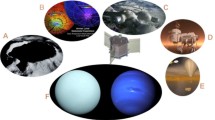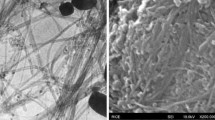Abstract
A radioisotope thermoelectric generator (RTG) is a device that directly converts the decay heat of a radioisotope into electrical energy using the Seebeck effect of a thermoelectric material. The constant decay of the radioisotope heat source produces heat as a system energy source. The thermoelectric module uses materials to obtain electric energy by Seebeck effect. The structure and size of the thermoelectric converter need to be optimized for different radioisotope heat sources. The power has stable output performance, sustainable operation, and strong environmental adaptability. Space micro-scientific instruments require power supplies that are sustainable, stable, and long-life. The micro radioisotope thermoelectric generator can be invoked as a sustainable long-life power supply in low-power device applications. The miniaturized RTG can be applied in long-term service meteorological/seismic monitoring stations that are widely distributed on the surface of the planet, small landing vehicles at extreme latitudes or areas with low solar flux, atmospheric-surface-flow monitoring systems, underground detectors, deep space micro spacecraft, wireless sensor networks, self-powered radiation sensors, deep-space robot probes, and radio observatories on the lunar surface. This study innovatively proposes micro stacked-integrated annular-radial radioisotope thermoelectric generator and prepares an integrated prototype to drive an RF2500-based radiofrequency wireless sensor network, and monitors the temperature of each node for a long time as a demonstration. A high-performance micro radioisotope thermoelectric generators module based on the flexible printed circuit and bismuth telluride thick film was designed and prepared by screen printing. They are tested by a loading electrically heated equivalent radioisotope heat source. The output performance of the micro-RTG at different ambient temperatures is further evaluated. When loaded with 238PuO2 radioisotope heat sources, an integrated prototype would generate an open-circuit voltage of 0.815 V, a short-circuit current of 0.551 mA, and an output power of 114.38 µW at 0.408 V. When loaded with a 90SrTiO3 or 241AmO2 radioisotope heat source, the prototype produced 66.38% and 6.15% of the output power (compared to 238PuO2), respectively. In the impact evaluation on ambient temperature, the electrical output performance of the prototype increases with increasing temperature (− 30 to 120 °C). In the evaluation of the effects of long-term radioisotope irradiation, the output performance decreased slightly as the irradiation dose was increased during the service period. The stack-integrated micro radioisotope thermoelectric generator developed in this study is expected to provide reliable power support for space micro-scientific instruments, especially distributed wireless sensor networks.






Similar content being viewed by others
References
Prelas M, Boraas M, De La Torre Aguilar F, Seelig JD, Tchouaso MT, Wisniewski D (2016) Nuclear batteries and radioisotopes. Springer, Cham, pp 286–287. https://doi.org/10.1007/978-3-319-41724-0
Prelas MA, Weaver CL, Watermann ML, Lukosi ED, Schott RJ, Wisniewski DA (2014) A review of nuclear batteries. Prog Nucl Energy 75:117–148. https://doi.org/10.1016/j.pnucene.2014.04.007
BairstowB, Lee YH, Oxnevad K (2018) Mission analysis for next-generation RTG study. In: IEEE aerospace conference proceedings, pp 1–19. https://doi.org/10.1109/AERO.2018.8396411
Bass JC, Allen DT (1999) Milliwatt radioisotope power supply for space applications. In: Proceedings, ICT’99 (Cat. No. 99TH8407) eighteenth international conference thermoelectr, pp 521–524. https://doi.org/10.1109/ICT.1999.843443
PustovalovA, Gusev V, Borshchevsky A, Chmielewski A (1999) Experimental confirmation of milliwatt power source concept. In: Proceedings ICT’99 XVIII international conference thermoelectric, pp 500–504
Khajepour A, Rahmani F (2017) An approach to design a90Sr radioisotope thermoelectric generator using analytical and Monte Carlo methods with ANSYS, COMSOL, and MCNP. Appl Radiat Isot. https://doi.org/10.1016/j.apradiso.2016.11.001
Abelson RD, Balint TS, Marshall KE, Noravian H, Randolph JE, Satter CM, Schmidt GR, Shirley JH (2004) Enabling exploration with small radioisotope power systems. Jet Propulsion Laboratory, National Aeronautics and Space, Pasadena, pp 2–5
Heshmatpour B, Lieberman A, Khayat M, Leanna A, Dobry T, El-Genk MS (2008) Special application thermoelectric micro isotope power sources. In: AIP conference proceedings AIP, pp 689–695. https://doi.org/10.1063/1.2845032
Roundy S, Steingart D, Frechette L, Wright P, Rabaey J (2004) Power sources for wireless sensor networks. Sens Netw. https://doi.org/10.1007/978-3-540-24606-0_1
Mohamed NS, Wright NG, Horsfall AB (2017) Self-powered X-Ray sensors for extreme environments. In: Proceedings IEEE sensors. https://doi.org/10.1109/ICSENS.2017.8234008.
BahramiP, Nesmith B, Carpenter K (2017) Milli-watt radioisotope power to enable small, long-term robotic “probe” space exploration. In: IEEE aerospace conference proceedings, pp 1–8. https://doi.org/10.1109/AERO.2017.7943899
MacDowall R (2018) Low-frequency radio observatory on the lunar surface (LROLS). In: Am. Astron. Soc. Meet. Abstr., pp 232
Gusev VV, Pustovalov AA, Rybkin NN, Anatychuk LI, Demchuk BN, Ludchak IY (2011) Milliwatt-power radioisotope thermoelectric generator (RTG) based on plutonium-238. J Electron Mater. https://doi.org/10.1007/s11664-011-1579-z
Selvan KV, Hasan MN, Mohamed Ali MS (2018) Methodological reviews and analyses on the emerging research trends and progresses of thermoelectric generators. Int J Energy Res 43:113–140
Fang H, Popere BC, Thomas EM, Mai CK, Chang WB, Bazan GC, Chabinyc ML, Segalman RA (2017) Large-scale integration of flexible materials into rolled and corrugated thermoelectric modules. J Appl Polym Sci. https://doi.org/10.1002/app.44208
Yuan Z, Tang X, Liu Y, Xu Z, Liu K, Zhang Z, Chen W, Li J (2017) A stacked and miniaturized radioisotope thermoelectric generator by screen printing. Sens Actuators A Phys 267:496–504. https://doi.org/10.1016/j.sna.2017.10.055
Yuan Z, Tang X, Xu Z, Li J, Chen W, Liu K, Liu Y, Zhang Z (2018) Screen-printed radial structure micro radioisotope thermoelectric generator. Appl Energy 225:746–754. https://doi.org/10.1016/j.apenergy.2018.05.073
Yuan Z, Tang X, Liu Y, Xu Z, Liu K, Li J, Zhang Z, Wang H (2019) Improving the performance of a screen-printed micro-radioisotope thermoelectric generator through stacking integration. J Power Sour 414:509–516
Acknowledgements
This work is supported by the Shanghai Aerospace Science and Technology Innovation Project (Grant no. SAST2016112); the Funding of Jiangsu Innovation Program for Graduate Education (Grant no. KYLX16_0355).
Author information
Authors and Affiliations
Corresponding author
Rights and permissions
About this article
Cite this article
Yuan, Z., Liu, K., Xu, Z. et al. Development of Micro-radioisotope Thermoelectric Power Supply for Deep Space Exploration Distributed Wireless Sensor Network. Adv. Astronaut. Sci. Technol. 3, 157–163 (2020). https://doi.org/10.1007/s42423-020-00062-1
Received:
Revised:
Accepted:
Published:
Issue Date:
DOI: https://doi.org/10.1007/s42423-020-00062-1




